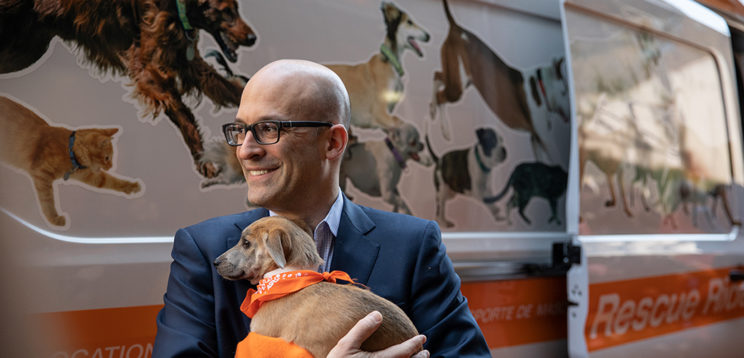
The ASPCA took in roughly $263 million in 2017. That same year, ASPCA CEO Matt Bershadker had take home compensation totaling $852,231. Yet according to transporters, the ASPCA did not spend $15,000 to protect dogs by equipping each transport van with an HVAC system, a fraction of Bershadker’s salary and only 1/200th of 1% (0.006%) of total revenues.
Twenty dogs died at the hands of the ASPCA this month. The agency, which refuses to provide any details other than to say the dogs died in transport, claims to be investigating itself. According to the New York Post, which broke the story based on an internal email from ASPCA CEO Matt Bershadker which was leaked to the press, the “dogs died while the nonprofit was transporting them from a site in Mississippi to one in Wisconsin:”
The ASPCA does not know “where along the trip the dogs died” other than to say it “was not the result of a car crash.” That means no one checked on the dogs on the 700-mile trip between the time they left Mississippi and arrived, dead, in Wisconsin, roughly 11 or so hours later assuming no delays and no “pit stops.”
As the ASPCA will not provide any information, I spoke to transporters about what most likely killed the dogs. The consensus among the transporters I spoke with is that there are two likely causes of death: heat or carbon monoxide. While the weather was mild the closer the transport got to its final destination, it was 87 degrees in Mississippi.
According to the American Veterinary Medical Association,
The temperature inside your vehicle can rise almost 20 º F in just 10 minutes. In 20 minutes, it can rise almost 30 º F: and the longer you wait, the higher it goes. At 60 minutes, the temperature in your vehicle can be more than 40 degrees higher than the outside temperature. Even on a 70-degree day, that’s 110 degrees inside your vehicle!
With temperatures near 90 in Mississippi and dogs packed tightly in crates, the temperature inside the vehicle could have reached almost 135 degrees in as little as one hour.
An ASPCA position statement on transport for animals says that it advocates “Protecting animals from inclement weather and adverse environmental conditions such as excessive heat or cold” and “Planning for unexpected changes in routing or schedule, including access to food, water and rest at appropriate intervals.” It failed to practice what it preaches.
Tom Vaccarella, one of the transporters I spoke with, has driven roughly 6,000 dogs across country, without incident. He says that regardless of what caused the deaths, the ASPCA is complicit due to “neglect” and “not caring.” When he transports animals from shelters to rescuers, he only drives them in a trailer with climate control. All dogs in his care also receive water, dog food, positive ventilation/air conditioning, and music to reduce stress. In addition, he maintains CCTV so he can see the dogs while driving and a digital thermostat reader so he always knows the temperature in the bed. Additionally, his trailer includes a carbon monoxide detector and smoke detector.
Roughly every four hours of driving, he stops to inspect the dogs, top off the water, and walk the dogs. The dogs are taken out by members of his crew individually and walked using a slip lead. If they are soiled, their crates are cleaned and disinfected, and if necessary, the dogs are bathed. He has never had a dog die in transit.
ASPCA trucks, he says, have none of these protections and ASPCA transport staff do none of these things. Despite over $250 million in annual revenues, making it one of wealthiest charities worldwide (and that includes all charities, not just “animal protection” ones), Vaccarella says that the ASPCA did not spend the $15,000 or so it would cost to equip each transport van with climate control and other protections. Only their disaster vans, he says, have such generators. The transport vans are low budget cargo vans with dogs in crates, packed in tightly, held from bouncing around with bungee cords. They do, however, spend the $5,000 it costs to wrap the vehicle with their name on it.
While we wait for the results of the ASPCA’s internal investigation, one thing is certain Vaccarella says. Given that the ASPCA does not know where the dogs died along the route, it is clear that they were not afforded minimal protections during the drive. “It’s inhumane,” he says.
If he is right, it should also be criminal.
————-
Have a comment? Join the discussion by clicking here.